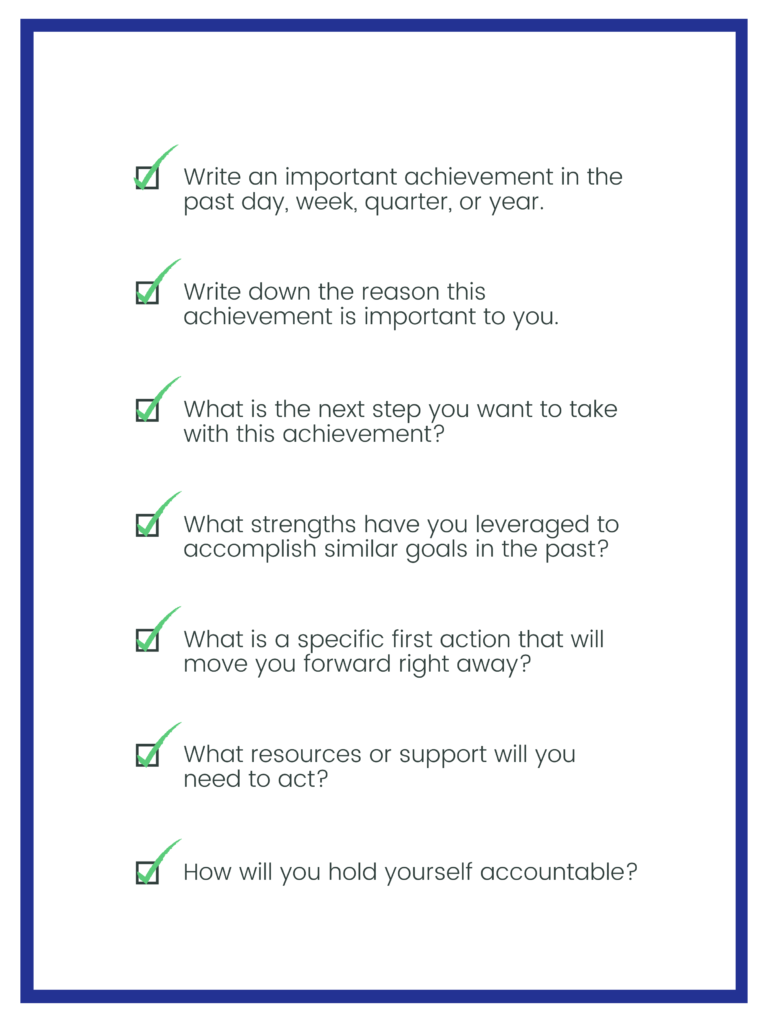23 Dec Change Management for 2021
SEVEN STEPS TO SELF-DETERMINED CHANGE
This year has thrown changes at us like we’ve never quite experienced before – just as we’re getting used to one seemingly impossible change, another comes hurtling towards us. The comfort of the familiar, the predictable, and the ordinary seems like an old, childhood memory at this point.
So, with 2020 coming to an end and 2021 almost here, how can we make the change in our lives more manageable?
While I don’t have any quick tips for how to effectively end all change in your life (which would become very boring after a while), I do have steps I stand by to generate positive change for your life: The Seven Steps to Self-Determined Change. These steps, which are based on a study of positive psychology called Appreciative Inquiry, are meant to put a focus on the possibilities and propel you forward to achieving those possibilities through incremental progress.
We can’t alter the changes that surround us, but we can look to these steps as the new year approaches to create the positive change we deserve.
SURVIVING 2020’S CHANGES
The pandemic has demanded change from each of us, causing significant stress day-to-day and, some days, becoming overwhelming. It’s easy to remain preoccupied with navigating and surviving that change while overlooking its impact on us. But then, inevitably, all those impacts sneak up on you.
For example, every Sunday after Thanksgiving, our family comes together to decorate the Christmas tree. This year, however, a comment was made in the midst of Thanksgiving dinner preparations. The comment, which came from a place of fatigue due to ten months of a pandemic, suggested that the tree trimming wasn’t necessary since extended family wouldn’t be visiting this year. That simple comment was met with an unexpected freak-out by my 19-year-old daughter: “Absolutely not! We CANNOT skip the tree!”
2020 has been a year of so much change for my daughter (and the rest of us) that the thought of canceling this life-long tradition was too much, resulting in a reaction that none of us anticipated coming from her. Going to college, moving into an apartment, virtual classes, and the pandemic all caused an excessive amount of change – and missing out on the tree trimming was the last straw.
The comment was quickly dismissed, the tree was decorated as per tradition, the family enjoyed a great afternoon together which included dinner in front of this year’s tree.
Like my daughter, we all spent the year focused on navigating and surviving the changes thrown at us. And as much as we want it to, the world isn’t going back to “normal” anytime soon. With the vaccine in the early stages of distribution, many of us won’t receive it until Q3 2021.
So, moving forward, what can we expect in 2021? How can we thrive in the midst of the current environment?
MOVING PAST SURVIVAL MODE
Many of us are still in survival mode. Our brains and bodies are hardwired with a threat-seeking radar programmed by genetics and life experiences. Emotions are all over the place right now – fear, anxiety, anger, and even shame. We’re focused on the threats we face and consumed with problem-solving because we can’t run away or hide from it.
So, to regain control, eliminate the threat, and get back to “normal,” we react in various productive or non-productive ways. For many of us, working too many hours and generally being out of sync with life as we knew it seems to be that reaction.
When we’re faced with an ongoing threat and can’t seem to find a solution to the problem, our fight or flight impulses may cancel each other out, leading to a freeze-response of despair and demotivation. Some of us may even choose to ignore the threat and appear complacent.
So, how do we work through this? How do we increase positive emotions like excitement, passion, and pride?
The ambiguity and lack of certainty about the future pulls us into reacting with a short-term problem-solving approach. What if we look through a different lens at the possibilities that are before us? What opportunities can be brought into focus that are more long-term? How might we balance both a short-term and long-term outlook to addressing the threat before us?
SEVEN STEPS TO SELF-DETERMINED CHANGE
In our individual best interests, searching for what is going well and recognizing achievements is a first step toward switching our mindset from surviving to thriving. If you follow the Seven Steps to Self-Determined Change and focus on possibilities, you will discover and put a spotlight on the best of “what is” about yourself and propel yourself toward “what might be.”

Write down an important achievement in the past day, week, quarter, or year.
Write down the reason this achievement is important to you.
What is the next step you want to take with this achievement?
The first three steps are intended to ignite self-reflection and emphasis around an achievement that is significant, an achievement you can expand upon, or an achievement that lays the foundation for what is next. What are the next possibilities with that achievement?
What strengths have you leveraged to accomplish similar goals in the past?
Next, more self-reflection. What strengths, skills, experience, and knowledge did you use when accomplishing similar goals in the past? This question is drawing upon self-efficacy, which is believing you can accomplish what you want to accomplish through your own actions. It is perhaps the most important element of achieving a successful outcome – believing that you can.
It’s worth mentioning that self-efficacy is commonly confused with self-confidence. Self-confidence refers to the belief in one’s self-worth and the likelihood of succeeding. You could be confident that you will fail or succeed, right? So, confidence is more of a general term – you can have a strong positive or negative belief in anything. With self-efficacy, it is about having a strong, positive belief that you have the capacity and the skills to achieve a particular goal.
What is a specific first action that will move you forward right away?
A way to build self-efficacy is to establish incremental goals – the smallest attainable action to move forward is better than no action. Think progress over perfection. When achieving incremental goals, you build competency. Increased competency leads to enhanced confidence, and enhanced confidence leads to the desire to further increase competency. So, you can create a cycle of forward movement that perpetuates itself. Ever heard of the phrase, success leads to more success?
What resources or support will you need to act?
The next step is to think about the resources or support you might need to move toward your next achievement. Do you need a mentor? Will a new skill set be required and how will you learn it? What support system do you have in place? Who do trust to share the context or goal you are trying to achieve, and can they provide feedback?
How will you hold yourself accountable?
And finally, step seven, how will you hold yourself accountable? How will you persevere through setbacks and around obstacles to reframe and think of them as learning opportunities on your journey toward goal attainment? When working to create a positive mindset, it is important to be aware of the danger of perfectionism. Talking about, thinking of, or striving for perfection is a trap – you want to strive for progress. Small wins enhance confidence and build your competence and capabilities – you are building self-efficacy.
Think about the genesis of the steps – you are building on a prior achievement. So, as you move forward with incremental goals, the ultimate goal does not have to be finished to recognize achievements. Small wins lead to big wins. When things do not go as planned take the approach of looking at the situation in a different way – what can be learned from the experience or situation? Think of setbacks as opportunities for growth. Ask yourself, “What did I learn, and what will I do differently next time?”
As you use the seven steps, over time you will begin to stretch yourself and set higher-level goals and develop strategies to sustain efforts in achieving the goals. You will find that perseverance in the face of obstacles is not the challenge it was before. You will bounce back from setbacks more quickly and experience overall reduced stress.
Learn More
Our subject matter experts are frequently invited to share their thought leadership on change management as well as other topics. To learn more or request a presentation, visit our Speaker’s Bureau.
Learn More
Our subject matter experts are frequently invited to share their thought leadership on change management as well as other topics. To learn more or request a presentation, visit our Speaker’s Bureau.




